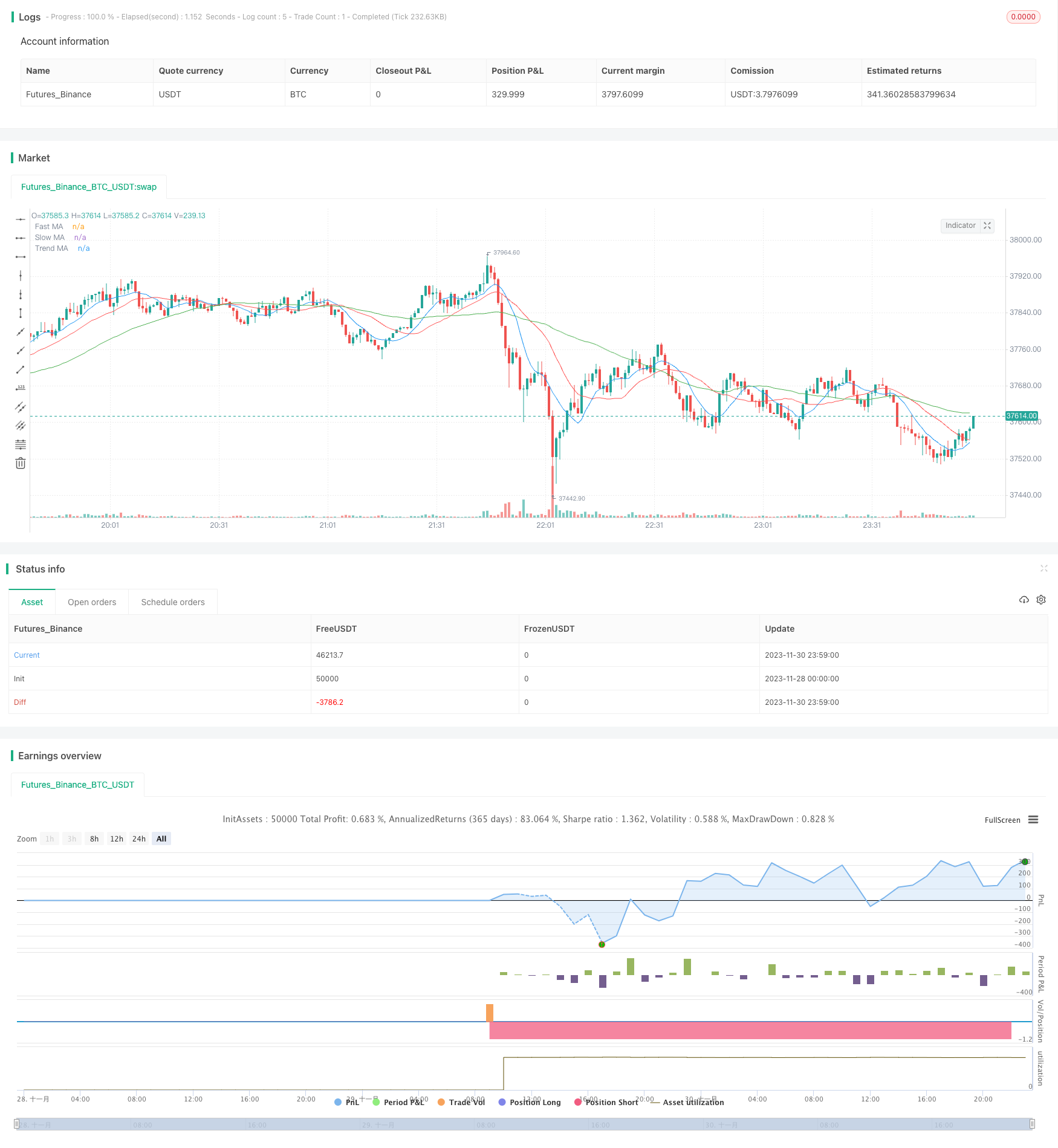
概述
三重移动平均线顺势交易策略通过计算三条不同周期的移动平均线,判断市场趋势和买卖时机。策略首先计算快线、慢线和趋势线三条移动平均线,然后结合快线和慢线的黄金交叉以及死叉信号,判断具体的买入和卖出时机。同时,策略引入趋势线判断市场趋势方向,只有在趋势线判断为上升趋势时买入,下降趋势时卖出,从而避免逆势交易。
策略原理
三重移动平均线顺势交易策略的核心逻辑是同时利用快线、慢线和趋势线三条移动平均线指标判断买卖时机。首先,策略分别设置周期参数,计算出三条不同周期的移动平均线。然后,通过快线和慢线的交叉关系来判断买入和卖出信号。具体来说,当快线上穿慢线时产生买入信号,而快线下穿慢线时产生卖出信号。这是经典的双移动平均线交易策略的信号判定机制。
在此基础上,本策略进行了优化,增加了市场趋势判断的环节。引入第三条周期更长的趋势线,用于判断市场整体走势。只有当判断为上升趋势时,才对快慢线的买入信号进行交易,只有在下降趋势时,才对快慢线的卖出信号进行交易。这样可以有效过滤掉部分逆势交易的信号,从而降低交易风险,提高盈利概率。
优势分析
本策略相比简单双移动平均线策略,具有以下几点优势:
增加了对市场趋势的判断,有效避免逆势交易,可以过滤掉一部分亏损交易,降低风险。
多条移动平均线组合使用,可以提高信号的可靠性和胜率。
周期参数可以灵活调整,适应不同市场环境,灵活度高。
策略规则清晰易懂,容易实施。相比机器学习等复杂策略,实施难度不高。
指标和策略都较为常见,多用于量化交易,经过长期验证,理论依据可靠性高。
风险分析
尽管相比简单双均线策略有所优化,但本策略仍存在一定的风险需要注意:
三条均线增加了策略复杂度,存在多参数优化难度大,调参效果欠佳的风险。
均线指标本身滞后性较大,可能出现识别信号不明显或信号延迟的情况。
趋势判断依据较为主观,存在判断失误风险,无法完全避免逆势交易。
策略默认全仓交易,存在资金管理和风险控制机制不完善的问题。
纯规则式策略,无法实时跟踪市场变化调整参数,鲁棒性欠佳。
针对以上风险,可通过严格的回测验证、全面的参数优化,引入止损机制、资金管理模块,以及结合机器学习模型动态调整参数等方式进行优化和改进,降低交易风险。
优化方向
本策略的优化空间还比较大,主要可以从以下几个方面进行完善:
增加止损机制。可以设置移动止损或者振幅止损,有效控制单笔交易的最大损失。
引入仓位管理模块。可以根据回撤、资金使用率等指标动态调整仓位大小,降低风险。
多时间框架结合。可以在多种不同周期(日线、60分钟等)下验证策略效果,结合更多时间维度。
参数优化与 ensemble 模型。可以通过网格搜索、遗传算法等方法对参数进行优化。也可以训练多个模型,结合其交易信号。
基于机器学习的动态调参。通过 Reinforcement Learning 等技术实现模型的自动化优化和调参。
结合更多指标和过滤规则。如引入成交量,价差,波动率等指标进行选股过滤,降低误导信号。
总结
本策略总的来说,这种改进的移动平均线交叉策略指导交易者顺应整体市场趋势进行交易,以避免逆势交易。这显示出比简单的双重移动平均线交叉策略更有希望提高风险调整后的回报。但是,通过仓位大小调整、机器学习适应等方式可以进一步优化它。使用移动平均线进行趋势跟踪的核心原则似乎是可靠的。
/*backtest
start: 2023-11-28 00:00:00
end: 2023-12-01 00:00:00
period: 1m
basePeriod: 1m
exchanges: [{"eid":"Futures_Binance","currency":"BTC_USDT"}]
*/
//@version=5
strategy("Improved Moving Average Crossover Strategy", overlay=true)
// Define input variables
fast_length = input(9, title="Fast MA Length")
slow_length = input(21, title="Slow MA Length")
trend_length = input(50, title="Trend MA Length")
src = close
// Calculate moving averages
fast_ma = ta.sma(src, fast_length)
slow_ma = ta.sma(src, slow_length)
trend_ma = ta.sma(src, trend_length)
// Plot moving averages on the chart
plot(fast_ma, color=color.blue, title="Fast MA")
plot(slow_ma, color=color.red, title="Slow MA")
plot(trend_ma, color=color.green, title="Trend MA")
// Define trend direction
is_uptrend = ta.crossover(slow_ma, trend_ma)
is_downtrend = ta.crossunder(slow_ma, trend_ma)
// Define buy and sell conditions
buy_condition = ta.crossover(fast_ma, slow_ma) and is_uptrend
sell_condition = ta.crossunder(fast_ma, slow_ma) and is_downtrend
// Execute trades based on conditions
if (buy_condition)
strategy.entry("Buy", strategy.long)
if (sell_condition)
strategy.close("Buy")
if (sell_condition)
strategy.entry("Sell", strategy.short)
if (buy_condition)
strategy.close("Sell")